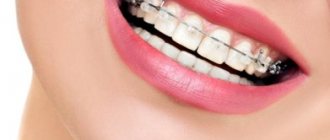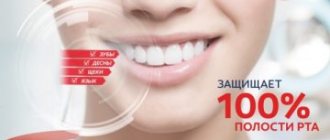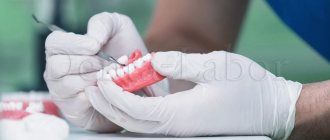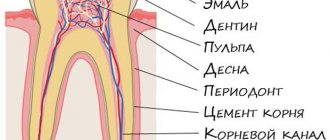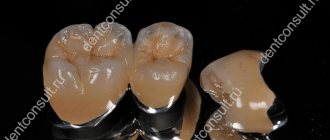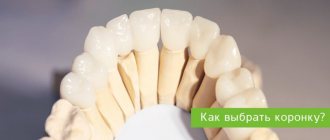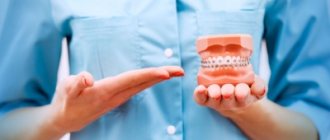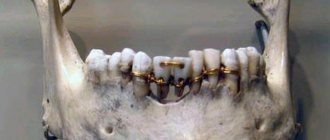If a toothache occurs, we will sooner or later turn to the dentist; if the case is advanced, then to the surgeon. What if all the teeth are healthy, but the patient does not like the aesthetics of the smile - an orthodontist will come to the rescue.
Orthodontics is a dental branch that deals with the diagnosis and correction of dentofacial abnormalities - dental curvature or malocclusion.
Additional information : the term orthodontics from Greek literally translates as “straight tooth”.
Orthodontist: what he does and what he treats
The services of the dental clinic include orthodontic treatment. Orthodontics is a branch of dentistry that studies the causes of dental anomalies, methods for their diagnosis and correction. Dental anomalies are widespread among diseases of the maxillofacial system.
An orthodontist is a doctor who diagnoses and treats dental anomalies in children and adults. This is a narrow dental specialty: the doctor undergoes five years of training at a medical institute, then two years of residency in the specialty “Orthodontics”. This doctor treats adults and children.
What is orthodontics?
Orthodontics is a field of dentistry dedicated to the study, correction and prevention of developmental disorders of the dentition and abnormal bite formation.
Studies have shown that more than 90% of people have deviations in the development of the dental system. More than half of them require mandatory treatment . And this is where orthodontics can help.
Modern methods make it possible not only to successfully solve problems of smile aesthetics, but also of the profile as a whole. Orthodontic treatment can be carried out equally successfully in both childhood and adulthood.
What does an orthodontist treat?
A doctor of this specialty in dentistry in Otradnoye treats:
- bite pathologies: mesial, distal, deep, straight, open, cross;
- crooked teeth;
- anomalies in the timing of tooth eruption: delayed eruption, late eruption, etc.
- incorrect position of the tooth/teeth in the oral cavity, when one or more teeth are located abnormally, for example, outside the dentition;
The orthodontist also diagnoses abnormalities in the number, size, shape of teeth and refers the patient to related specialists for treatment: an orthopedist, a therapist, a surgeon.
Who is it?
Correcting the position of teeth, correcting incorrect occlusion and abnormal bite using available methods is the main job of an orthodontist.
An orthodontist analyzes pathology, diagnoses, selects the most appropriate treatment method, and carries out a number of preventive measures aimed at preventing the occurrence of diseases.
A timely visit to this specialist will help you avoid problems with your gums and dental tissue.
In addition to basic knowledge and practice, an orthodontist must have patience, communication skills and psychological skills , since the main point in the work is confidential contact with the patient. A pediatric orthodontist should especially understand this.
What diseases are most often treated by an orthodontist?
Most often, patients come to this doctor to correct their malocclusion. Moreover, patients notice such pathologies
Among the pathological bite are:
- Mesial (progenic): in the anterior region, the lower incisors overlap the upper ones or form a direct closure. With this pathology, the patient experiences protrusion of the lower jaw.
- Distal: The upper front teeth protrude above the lower teeth. The front teeth do not close together; upon examination, a gap is visible between them. The lower jaw is behind the upper jaw.
- Crossbite: there is a violation of the facial configuration, a displacement of the chin towards the lips.
Treatment of malocclusion must be started in a timely manner to avoid complications. We recommend that you consult with an orthodontist to determine if your situation has an overbite and how to treat it.
Comments
At 30 years old, does it make sense to get braces or do I need to undergo another course of treatment? If realistically, then approximately how long will they need to be worn and how effective is this method of treatment for an adult?
Victor (08/14/2018 at 11:36 am) Reply to comment
- Victor, bite problems can and should be solved at any age. As for choosing an orthodontic system that will help most effectively in your case, only an orthodontist can give advice based on examination, diagnosis and condition of the teeth and the entire dental system. And not at the first consultation, but after taking all the necessary parameters. In case of significant pathologies, braces will be one of the best solutions that can correct the situation within 1.5-2 years. It is also important that the braces will be fixed on two jaws at once (as a rule, first on one, and after a few months on the other) in order to even out the bite as a whole. But this depends, again, on the pathology. In any case, consult a doctor, your bite can be corrected!
Editorial staff of the UltraSmile.ru portal (09.17.2018 at 13:22) Reply to comment
Now it’s clear how an orthodontist differs from an orthopedist. I was constantly confused. Tell me, is there data on the effectiveness of various brace systems? I want to install lingual ones, but I’m not sure that they are better than traditional ones.
Olga (08/14/2018 at 12:01 pm) Reply to comment
- Hello Olga! Metal braces give the fastest results; ceramic and sapphire braces last longer. Self-ligating systems also solve the problem very quickly, and they do not require such frequent visits to the orthodontist. As for lingual systems, they are, of course, better than traditional ones in terms of aesthetics - they are completely invisible. But screenings are not for everyone - they can only be performed for certain malocclusion pathologies.
Editorial staff of the UltraSmile.ru portal (09.17.2018 at 14:56) Reply to comment
My adult son, 27 years old, is missing two sixth teeth. The dairy ones fell out, but the permanent ones did not grow. X-rays do not show the presence of new tooth buds. What to do now and where to find an orthodontist who has already solved a similar problem?
Olga (08/14/2018 at 12:08 pm) Reply to comment
- Dear Olga! In general, each tooth has a specific place in the jaw, so displacing some in place of others is a fundamentally incorrect position, because they have a different shape, are designed for a different load, and have different antagonist teeth. Therefore, it is still better to contact not an orthodontist, but an orthopedist who will perform dental implantation or install bridges. This will be a better decision.
Editorial staff of the UltraSmile.ru portal (09.17.2018 at 15:00) Reply to comment
We have encountered an orthodontist more than once, since many relatives in our family have an anomaly associated with teeth - the fangs grow second row, above the teeth. Daughters and nieces about 15 years ago, this problem was “successfully” resolved by surgeons. They just took and removed healthy teeth so that the fangs would fall into place. This is already the second grandson walking around with briquettes. But I'm afraid they turned up too late. Tell me, should we have consulted a specialist before these molars appeared or is it still fixable? The child is 14 years old.
Julia (08/14/2018 at 12:44 pm) Reply to comment
- Hello Julia! This phenomenon is usually called “crowding” and it can indeed be predetermined by heredity. You have already started treatment with braces, so it is more likely to help you. Removing fangs is not an option; aesthetics will be compromised. With this pathology, the distant chewing teeth are most often removed, which makes it possible to free up space for the front teeth. Although everything is individual. And yes, you should have contacted an orthodontist much earlier - you could have started treatment at the age of 6-7 years to correct the situation at the initial stage.
Editorial staff of the UltraSmile.ru portal (09.17.2018 at 15:04) Reply to comment
Unfortunately, when we were growing up, and this is the Soviet “happy childhood”, such specialists were extremely rare, so I live with an incorrect bite, and hence the conclusions, by the age of 45, oral problems have become not only acute, we now have to solve these issues. The orthodontist, as my grandchildren say, is tooth fairies and volebniks, corrected everyone’s malocclusion.
Anna Pavlovna (08/14/2018 at 12:48 pm) Reply to comment
- Dear Anna Pavlovna! Even at your age, it is not too late to solve the problem of malocclusion. There are cases where people were treated with braces at 50 and even 60 years old. The main thing is that there would be living teeth that need to be straightened! Of course, the older the person, the more work will be required - after correcting malocclusion pathologies, it will be necessary to work on the restoration of the teeth, that is, restore their shape. Throughout life, teeth wear down and their chewing surfaces change—this becomes especially noticeable after orthodontic treatment. That is why you will need to visit a therapist and replace the fillings, perhaps even put crowns and core inlays on some teeth. First, visit your doctor! Consultations in many clinics today are completely free and do not obligate you to anything.
Editorial staff of the UltraSmile.ru portal (09.17.2018 at 15:51) Reply to comment
Please tell me at what age can a brace system be installed? My daughter’s teeth are growing crooked and need to be corrected. Different clinics call different ages. Who to listen to?
Alina (08/16/2018 at 14:50) Reply to comment
- Hello, Alina! It is best to begin treatment with braces when the final replacement of baby teeth with permanent ones has occurred. For most children this happens by the age of 13, for some a little earlier - at 10-12. Previously, you could use other means of correction - for example, plates. Note that in some cases, before installing braces, you need to wear certain devices - for example, the same plates. In particular, in order to change the shape of the upper or lower jaws. So it is likely that you can start orthodontic treatment now, before the bite is completely changed and braces are installed.
Editorial staff of the UltraSmile.ru portal (09.17.2018 at 15:55) Reply to comment
As a child, I wore a plate to correct an overbite. But either the plate was chosen incorrectly, or I wore it irregularly, but the bite did not improve. Is it possible to correct a bite as an adult?
Maxim (08/16/2018 at 15:26) Reply to comment
- Good afternoon, Maxim! The bite can and should be corrected at any age. Adults are most often prescribed non-removable orthodontic devices for such purposes, namely braces. The plates are optimal for children under 11 years of age and really require a high level of control and responsibility, if not from the children themselves, then from their parents, because are removable.
Editorial staff of the UltraSmile.ru portal (09.17.2018 at 15:56) Reply to comment
After reading the article, it became easier to see how many ways there are to correct your bite and have a beautiful smile. My son is only a year and a couple of months old, but I have already begun to think about visiting an orthodontist. The baby has a fairly large gap between the upper units. Should I see a doctor now or is it better to wait until all the teeth have erupted? And is there a chance that after all the teeth appear, the gap will shrink?
Anna (08/16/2018 at 15:42) Reply to comment
- Dear Anna! For your peace of mind, you need to show your baby to a pediatric orthodontist. The situation you describe can be compared to a phenomenon called “false diastema.” It can go away when the child reaches two or three years of age when the primary bite is finally formed, or after it is replaced with a permanent one - after all, the permanent teeth themselves are larger in size. Typically, the change from primary to permanent dentition begins at 6-8 years of age, but in any case, observation and control of the situation by a specialist today will not hurt.
Editorial office of the UltraSmile.ru portal (09.17.2018 at 16:00) Reply to comment
I would like to ask if I have heard that frequent teeth whitening can be harmful to tooth enamel. How often should this procedure be done so that the tooth enamel remains strong, but at the same time has the appearance of Hollywood actors?
Vladimir (08/16/2018 at 16:40) Reply to comment
- Vladimir, teeth whitening, if you do it in a dental setting, using professional products, is a safe procedure. It can be repeated every 1-3 years, depending on how long the result lasts. It must be maintained at home - with the help of hygiene and the same professional products that the dentist will individually select for you.
Editorial staff of the UltraSmile.ru portal (09.18.2018 at 14:49) Reply to comment
Please tell me, is it possible for the front teeth to wear off with an incorrect bite? What should I do if my front incisors are half worn away? Is it possible to build up teeth and straighten my bite?
Vladimir (08/16/2018 at 16:45) Reply to comment
- Vladimir, with an incorrect bite, the teeth actually receive a completely uneven load, so tissue abrasion is a normal consequence of such a pathology. You can grow teeth, but first you need to eliminate the cause, namely, malocclusion. Therefore, visit an orthodontist first, start undergoing treatment, and then consult a therapist to restore the aesthetics and shape of your teeth. Otherwise, the treatment will not give the expected result - the teeth will continue to wear out. It is likely that you will also need to get mouthguards for bruxism if you have a similar pathology to protect your teeth from overload.
Editorial staff of the UltraSmile.ru portal (09.18.2018 at 14:46) Reply to comment
Until recently, I had no idea that there were such specialists in dental correction. I'm wondering how the braces system is installed so that it doesn't scratch the enamel of the teeth? In addition, this system still needs to be regulated somehow.
Anatoly Stepanovich (08/30/2018 at 14:49) Reply to comment
- Anatoly Stepanovich, indeed, the profession of orthodontist is very complex, because you need not only to know how the entire jaw system functions, but also to understand how to correct the bite of a particular patient, so as not to harm, but to improve the situation (after all, we are not only talking about crooked teeth, but and incorrectly positioned jaws). As for braces. Their plates actually do not come into contact with the enamel, because they are held on by a special glue (dental adhesive or even composite). The metal arc also does not touch the enamel. Yes, the system needs to be adjusted regularly: ligature braces once a month, self-ligating braces - every 2 months.
Editor of the portal UltraSmile.ru (09.12.2018 at 08:59) Reply to comment
Very useful article. I'm going to see an orthodontist. I was interested in the aligner correction system. I wonder how a system consisting of elastic material can correct the bite? She can't transmit effort.
Anfisa (08/30/2018 at 14:57) Reply to comment
- Anfisa, thank you for your question and for your gratitude to our editors. The material is relatively elastic, and the aligners fit incredibly tightly onto all teeth, so they exert a certain amount of pressure. Small, but still pressure. In addition, each aligner should be worn for about a couple of weeks, during which time the teeth will move slightly. And so on, step by step, gradually, but the bite will change. This entire process is initially thought out on a computer, followed by a thorough diagnosis, study of the condition of teeth and bone tissue, which allows you to design the process from start to finish WITHOUT errors.
Editor of the portal UltraSmile.ru (09.12.2018 at 08:57) Reply to comment
They recommend that I get braces for correction and they say that I will need to wear them for a year. It turns out that a metal structure will be in your mouth for a whole year. The metal will oxidize and oxidation products will enter the stomach and digestive tract. Isn't it harmful?
Nina (08/30/2018 at 15:04) Reply to comment
- Dear Nina! Modern brace systems are created from very high-quality materials that do not oxidize or corrode, especially those created from more expensive metals, such as titanium. Budget analogues mainly use medical steel. You should not choose metal braces if you have an individual intolerance, allergic reactions may occur.
Editor of the portal UltraSmile.ru (09.12.2018 at 08:55) Reply to comment
Write your comment Cancel reply
How does an orthodontist perform diagnostics?
An examination and diagnosis is required before starting treatment. During the consultation, the orthodontist conducts:
- collection of patient complaints and anamnesis data;
- examination of the patient’s face: symmetry, proportionality, and facial profile are assessed;
- when examining the oral cavity, the doctor fills out the dental formula, determines the bite, examines the frenulum of the lips, tongue, etc.;
If parents and a child come to the clinic for orthodontic treatment, the doctor conducts a survey of the parents about the child’s condition, its characteristics, etc.
Additional research methods in orthodontics include:
- Measuring plaster models of jaws: the doctor takes impressions of the jaws and casts plaster models. They are used to measure the dentition, diagnose their symmetry, and more.
- Orthopantomography (OPTG): the resulting image shows all the teeth, their roots, rudiments, and the structure of the bone tissue of the jaws.
- Teleradiography (TRG) in the direct and lateral surfaces: allows you to study the structure of the facial skeleton, establish an accurate diagnosis, and also predict the success of treatment.
During the consultation, the orthodontist will tell you what studies will be required in this case and what treatment methods are possible.
D
Directions of orthodontic treatment
In the minds of patients, an orthodontist is a dentist who treats crooked teeth. Which is true, but that's only part of the orthodontist's job.
The main direction of orthodontics is the correction of congenital or acquired malocclusions and the elimination of the causes that led to the occurrence of the disease.
Pathologies included in the scope of activity of orthodontists:
- The main direction of orthodontics is the correction of congenital or acquired malocclusions
dysfunction of the speech apparatus and disturbances in the functioning of the respiratory system;
- changing the shape of the face;
- deterioration of chewing function;
- manifestations of bite pathologies;
- abnormal changes in the arrangement of individual teeth and dentition.
Depending on the time of development of clinical manifestations of the disease, pathologies are classified as:
- congenital - curvature of milk and permanent teeth, complete or partial edentia.
- appeared some time after the birth of the child;
- hereditary.
The responsibilities of an odontist include:
- preparation and implementation of orthodontic intervention;
- replacement of lost teeth;
- correction of the direction of tooth growth, jaw shape, facial part;
- preparation for orthopedic procedures.
The condition of the dentofacial apparatus directly affects the functioning of the gastrointestinal tract, and also has psychological significance, as it is associated with the aesthetic perception of the individual by society.
Psychological discomfort, in turn, negatively affects the functioning of the nervous system and internal organs, which is why it is so important, in case of problems with the jaw apparatus, to consult an orthodontist in a timely manner.
How does an orthodontist treat?
Correcting a malocclusion is possible in several ways:
- The bracket system is a complex in design, but highly effective system in modern orthodontics. It allows you to create a functional and aesthetic optimum in the human dental system. Suitable not only for children. In adulthood, it is also possible to correct the bite with braces.
Braces are structures made of special metal locks and arches installed on the teeth. They are non-removable. Correcting the bite requires long-term wearing (from a year or more). The duration of wearing depends on the initial situation, the age of the patient and the characteristics of the maxillofacial system.
- Orthodontic plates are special structures that have a plastic base and various metal fasteners, screws, hinges, and springs. They are used in children, starting with primary occlusion, as well as during the period of teeth change: up to 12-14 years. They allow you to expand, shorten, lengthen the dentition, move teeth, change their position and much more.
Plates are removable orthodontic structures that must be maintained. The type of plate and duration of wearing is determined by the orthodontist. The production of plates takes place in a dental laboratory using individual casts of the jaws.
The success of treatment with plates in childhood depends not only on the correct manufacture of the desired design, but also on a responsible approach to wearing the plate by parents and the child. You should strictly follow the doctor’s recommendations, wear the plate for the required number of hours a day, and perform the necessary hygiene procedures.
Methods
To treat orthodontic problems, the dentist uses two options: conservative and surgical.
The surgical method is used only in extreme cases when alternative therapy does not produce results.
The conservative method, on the contrary, is the preferred option and includes two techniques: myotherapy and hardware treatment.
Myotherapy
Myotherapy refers to special gymnastics aimed at stimulating the functioning of the jaw muscles. It is most effective in the treatment of childhood pathologies , at an age when installation of corrective structures is not possible. Included in adult therapy as a preventive measure.
Myotherapy includes the following:
- exercises aimed at working the tongue;
- tilting the head while chewing;
- gargling or yawning;
- massage the soft palate and gums with a brush.
Hardware treatment
This method is basic in orthodontics and includes the use of special corrective structures. Treatment in this way can be carried out at any age, but the older the patient, the longer the therapy.
The principle of the technique is that with the help of devices, the load on the jaw is evenly distributed.
To troubleshoot problems use:
- braces;
- aligners;
- records.
In this video, an orthodontist talks about ways to correct a bite.
Any structure is installed in one day, and this procedure takes no more than an hour.
Surgical
In severe cases of pathology, surgical intervention is resorted to. In this case, several options are possible:
- removal of interfering teeth;
- removal of part of the bone tissue;
- compactosteotomy: cutting the bone in the problem area.
As a rule, this method requires further treatment using conservative techniques.
Custom sports mouth guards
An orthodontist not only treats various pathologies, but also helps prevent dental injuries. Contact sports (boxing, hockey, football) require protection of the front teeth from accidental injury.
To protect the dentition, individual mouthguards are made. They fit precisely to the teeth, are securely fixed in the oral cavity and protect athletes from dental injuries. Made from hypoallergenic materials, used for adults and children.
To make such a mouth guard, you will need two visits to the doctor:
- Taking impressions of the jaws. They are sent to the laboratory, where plaster models are cast, and the mouthguard itself is then cast.
- When the mouth guard is ready, the patient is invited to try it on and is given the design. The doctor gives recommendations on how to care for the mouthguard.
Reasons for contacting
Basically, orthodontists are pediatric doctors:
- It is recommended to bring a child to an orthodontist at the age of 2-3 years, with the appearance of the first teeth
It is recommended to bring a child to an orthodontist at the age of 2-3 years, with the appearance of the first teeth;
- the second, mandatory, appointment occurs at the age of five, when baby teeth are replaced by permanent ones;
Special reasons to visit a doctor:
- bad habits of the child;
- steady mouth breathing;
- congenital pathologies;
- irregular shape and direction of growing teeth.
If measures are not taken in a timely manner, the anomaly will develop into a complex form.
In turn, visiting a dentist will allow you to use effective preventive methods and save your child, in the future, from wearing braces for many years.
Treatment during the retention period
After the main course on jaw formation is completed, it is necessary to undergo additional retention. This is the name given to the process of consolidating the achieved result. As mentioned earlier, both removable and non-removable devices are used during treatment.
mouth guard
Immediately after eliminating the jaw abnormality, retainers are used; later, mouth guards are preferred, and only after the period prescribed by the orthodontist can additional equipment be abandoned. During the entire retention period, the doctor monitors the changes taking place inside the jaw row so that the reverse process does not begin.
There are circumstances that can affect the positive course of orthodontic treatment after removal of mechanical appliances, if retention is not carried out. Among them:
- possible growth of teeth, such as wisdom teeth;
- treatment can put teeth into an unstable position, which without proper control will cause remission;
- strong impact on the gums and teeth during treatment, which must be reduced in portions.
Causes of anomalies in the location of the dentition
At the appointment, the orthodontist is obliged to determine the causes of the disease, find out when the development of the pathology began and what type it is. This will help him choose the optimal treatment. The problem may be due to various reasons:
Hereditary
Various pathologies are often associated with heredity and are transmitted from parents to children at the genetic level.
Purchased
As a rule, they appear in childhood or adolescence and are associated with various bad habits, such as constantly sucking a pacifier or holding a pen or other objects in the mouth. They can also appear due to jaw injuries.
Having determined the reason why pathologies appeared in the development of the dental system, the orthodontist will prescribe an appropriate method to solve the problem. It must be remembered that almost all diseases can be treated, and as a result the patient will be able to achieve a healthy and beautiful smile.
Treatment methods
Today there are various ways to correct a bite. The most effective and gentle are hardware methods, that is, treatment using braces and aligners. In extremely severe cases, it is necessary to resort to surgical intervention.
Hardware treatment
To this day, braces remain one of the most popular and effective methods of correcting malocclusion. The design consists of special locks to which an elastic arch is attached. Trying to take the starting position, it puts pressure on the teeth, which is why they begin to move smoothly and slowly and take the correct position.
Treatment with braces really shows good results, but we must remember their disadvantages:
- highly noticeable to outsiders, which leads to complexes and decreased self-esteem
- non-removable, impossible to remove at an extremely critical moment
- quite inconvenient, causing discomfort and pain
- require restrictions on the menu - the patient cannot eat hard, crunchy, viscous foods
- very careful hygiene and purchasing additional oral care products (brush brushes, single-tuft brush)
- can lead to diseases of the teeth and gums due to poor hygiene and plaque accumulation.
Orthodontists strive to make these systems as comfortable as possible for the patient and unnoticeable to others. Thus, relatively recently, aesthetic invisible braces have appeared that are practically indistinguishable to outsiders - ceramic, lingual and sapphire. In such structures, the patient feels more confident and is much less susceptible to stress and complexes caused by the need for orthodontic treatment.
Aligners or aligners are an innovative method of correcting malocclusion, which is actively gaining a leading position. They are transparent overlays on teeth that almost completely reproduce the individual contours of the patient’s dentition. In areas of “mismatch,” the aligners apply gentle pressure to the teeth, causing them to gradually move into the correct position. For treatment, you will need several sets of aligners - each of them continues the work of the previous ones, forcing the tooth to continue to move in the desired direction.
Aligners appeared on the market relatively recently, but quickly gained popularity. For the first time in the world, Invisalign® teeth straightening aligners were released by the American company Align Technology in 1998. For twenty years, she continued to improve this system, created unique computer programs for diagnosing diseases and creating 3D models of dentition, and still remains a leader in this industry.
The following features and benefits have contributed to the success of the Invisalign® system:
- The aligners are made of transparent thermoplastic material and are completely invisible to strangers
- correct even complex malocclusion pathologies and effectively straighten teeth
- the unique ClinCheck Pro® program creates a 3D model of the dentition and demonstrates exactly how the teeth will move and what the smile will ultimately look like
- do not interfere, do not rub, do not injure gums
- do not cause oral diseases
- fit tightly on the teeth and do not interfere with diction
- thanks to the special ribbed inner surface, they are invisible even in photographs and in bright light
- do not require complex care, just wash them with a brush
- do not have metal parts, do not cause allergies to metal
- can be easily removed at an extremely important moment, for example, during a wedding ceremony
- You need to visit a doctor approximately once every 1.5-2 months
Experts agree that Invisalign® aligners are the future of modern orthodontics. Today, an increasing number of patients choose this particular method of bite correction.
Surgery
In case of skeletal abnormalities, orthodontic treatment is not enough, and orthognathic surgery is necessary to obtain a correct bite. Otherwise, it will be impossible to achieve the correct jaw relationship using braces or aligners alone.
